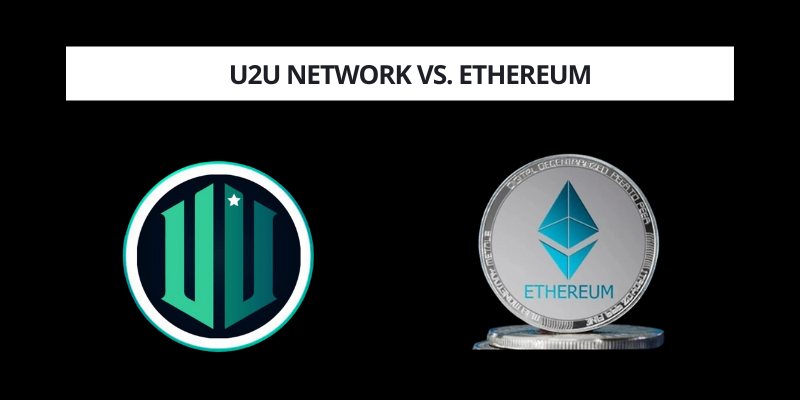U2U Network vs. Ethereum: Ecosystems Powering Decentralized Futures
The future of decentralized networks like U2U is unfolding as blockchain platforms evolve to meet diverse real-world needs, from financial systems to decentralized infrastructure. Ethereum, the world’s leading smart contract platform, has set the standard for decentralized applications (dApps), while U2U Network, a Layer-1 blockchain focused on Decentralized Physical Infrastructure Networks (DePIN), is carving a niche with its high-performance, modular ecosystem. This article. compares U2U and Ethereum, exploring their ecosystems, use cases, and roles in shaping decentralized networks.
Contents
Ecosystem Scale and Diversity
Ethereum’s ecosystem is the gold standard in Web3, hosting over 4,000 dApps across DeFi, NFTs, gaming, and stablecoins, with a total value locked (TVL) exceeding $100 billion as of April 2025. Projects like Uniswap, Aave, and OpenSea thrive on Ethereum’s robust infrastructure, supported by a global developer community and partnerships with enterprises like Microsoft and JPMorgan. Its native token, ETH, is a cornerstone of the crypto economy, with a market cap of $450 billion.
U2U Network, though newer, is rapidly building a DePIN-centric ecosystem, with over 80 dApps and 40 DePIN projects committed to its platform. Notable projects include U2DPN (a decentralized VPN with 71,000 nodes), Ermis (a real-time messaging app), and Ultimate Digits (Web3 mobile number NFTs). With over 1 million users and 100,000 daily active users, U2U’s ecosystem is growing, backed by $13.8 million in funding from KuCoin Ventures, Chain Capital, and IDG Blockchain. The future of decentralized networks like U2U lies in its ability to integrate physical infrastructure with blockchain, targeting sectors like IoT, healthcare, and telecommunications.
Real-World Applications
Ethereum’s versatility makes it a hub for financial innovation. Its DeFi protocols facilitate lending, borrowing, and trading without intermediaries, while NFT marketplaces enable digital ownership of art and collectibles. Stablecoins like USDT and USDC, built on Ethereum, maintain stable value for global transactions. Ethereum’s open financial system serves billions without access to traditional banking, cementing its role in Web3.
The future of decentralized networks like U2U is rooted in bridging digital and physical worlds through DePIN. U2U’s U2DPN, with over 69,000 GB of bandwidth shared by 60,000 users, enhances online privacy by transforming devices into nodes. Projects like LayerG support blockchain-based gaming, offering true asset ownership, while decentralized storage networks (DSNs) provide secure alternatives to centralized cloud providers. U2U’s focus on IoT and decentralized identities (DID) enables secure data sharing for smart cities and supply chains, addressing real-world scalability needs.
Community and Governance
Ethereum’s decentralized governance relies on its community of validators, developers, and the Ethereum Foundation, which coordinates upgrades like the 2022 Merge and 2024 Cancun update. Proposals like EIPs (Ethereum Improvement Proposals) ensure transparent evolution, though decision-making can be slow due to its vast stakeholder base.
U2U Network fosters community participation through initiatives like the DePIN Subnet Node Sale, allowing users to operate nodes on everyday devices and earn $U2U tokens from a 1-billion-token pool. Its governance model, supported by DPoS, empowers token holders to influence network decisions, aligning with DePIN’s user-driven ethos. The future of decentralized networks like U2U depends on this democratization, enabling individuals to contribute to decentralized infrastructure.
Adoption and Challenges
Ethereum’s widespread adoption is its strength, with integrations across exchanges, wallets, and cross-chain bridges like Binance Bridge and Polygon Bridge. However, high gas fees during peak usage and reliance on Layer-2 solutions can deter smaller projects. Regulatory scrutiny, particularly around DeFi and stablecoins, also poses risks.

U2U’s adoption is accelerating, with 180,000 wallet addresses and partnerships with AWS, Klaytn, and IoTeX. Its low-cost transactions and DePIN focus attract developers, but its smaller ecosystem and $678,000 market cap limit liquidity compared to Ethereum. Regulatory challenges around DePIN node operations and data privacy require careful navigation.
A Synergistic Path Forward
The future of decentralized networks like U2U complements Ethereum’s dominance rather than competing directly. Ethereum’s general-purpose platform excels in financial and digital asset applications, while U2U’s DePIN-focused ecosystem targets physical infrastructure integration. As U2U Co-Founder Luu Tran stated, “We’re building a decentralized platform for resource exchange, unlocking new economic opportunities”. By leveraging EVM compatibility, U2U can integrate with Ethereum’s ecosystem, enabling cross-chain innovation. Together, these platforms could power a future where decentralized networks seamlessly connect digital and physical worlds, driving Web3 adoption across industries.